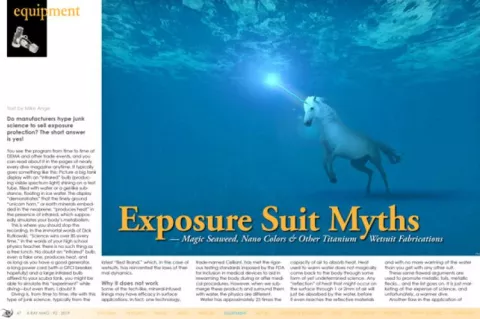Do manufacturers hype junk science to sell exposure protection? The short answer is yes!
Contributed by
Factfile
Mike Ange has worked in the dive industry for 29 years, 12 of those years in the senior management of exposure protection companies, including Huish, Waterproof, Harveys and Whites.
His suit design modifications have won awards, and he designed the first commercially viable thermal testing process for wetsuits in conjunction with Simon Fraser University in Vancouver, Canada, in 2018.
He has authored several books and manuals, including Diver Down: Real World SCUBA Accidents and How to Avoid Them published by McGraw Hill, Altitude Diving Manual published by SSI, TDI Advanced Wreck Diving Manual, and the SDI/TDI Diving Leadership Manual.
For more information, visit: mikeange.net.
You see the program from time to time at DEMA and other trade events, and you can read about it in the pages of nearly every dive magazine anytime. It typically goes something like this: Picture a big tank display with an “infrared” bulb (producing visible spectrum light) shining on a test tube, filled with water or a gel-like substance, floating in ice water. The display “demonstrates” that the finely ground “unicorn horn,” or earth minerals embedded in the neoprene, “produces heat” in the presence of infrared, which supposedly simulates your body’s metabolism.
This is where you should stop the recording. In the immortal words of Dick Rutkowski, “Science wins over BS every time.” In the words of your high school physics teacher, there is no such thing as a free lunch. No doubt an “infrared” bulb, even a fake one, produces heat, and as long as you have a good generator, a long power cord (with a GFCI breaker, hopefully) and a large infrared bulb affixed to your scuba tank, you might be able to simulate this “experiment” while diving—but even then, I doubt it.
Diving is, from time to time, rife with this type of junk science, typically from the latest “Best Brand,” which, in the case of wetsuits, has reinvented the laws of thermal dynamics.
Why it does not work
Some of the tech-like, mineral-infused linings may have efficacy in surface applications. In fact, one technology, trade-named Celliant, has met the rigorous testing standards imposed by the FDA for inclusion in medical devices to aid in rewarming the body during or after medical procedures. However, when we submerge these products and surround them with water, the physics are different.
Water has approximately 25 times the capacity of air to absorb heat. Heat used to warm water does not magically come back to the body through some form of yet undetermined science. Any “reflection” of heat that might occur on the surface through 1 or 2mm of air will just be absorbed by the water, before it even reaches the reflective materials and with no more warming of the water than you get with any other suit.
These same flawed arguments are used to promote metallic foils, metallic flecks... and the list goes on. It is just marketing at the expense of science, and unfortunately, a warmer dive.
Another flaw in the application of these technologies is the reversal of natural science. When we submerge the body in water, natural reflexes occur that shunt blood flow to the core of the body. This is Mother Nature’s method of retaining heat.
The peripheral areas of the body have a much larger surface-area-to-mass ratio, allowing much more rapid loss of retained heat. If we defeat the reflex, the body’s metabolic heat production cannot keep up with heat loss, even in waters approaching 88°F (31°C).
Many of the technologies used in surface tech are designed to, in part, increase peripheral blood flow, effectively defeating (or at least attempting to defeat) these common mammalian reflexes, and as a result, effectively accelerate heat loss. In short, you pay more to get significantly shorter and colder dives.
Actual heat-loss testing of neoprene rubbers and various inner-face linings clearly shows that the best insulation is the rubber alone. The science is simple: Rubber itself is an excellent insulator, and the less water we can flow into the suit, the less heat loss will occur.
Neoprene rubber and inner-face technologies
“Skin-in” rubber provides the most complete watertight seal to the diver’s skin. However, skin-in/skin-out neoprene rubbers are also the weakest material, tearing, cutting and ripping very easily. (Skin-out reduces friction for the most efficient swimming).
Suits made of bare rubber are most popular with extreme freedivers and triathletes who are both willing to lube their bodies to don the suit, in order to avoid stress (stretch) tearing, and to accept a limited life span for their suits. This is not a trivial matter, considering that the average diver may expect three to five years from a wetsuit, versus just three or four dives with the skin-in/skin-out suits.
The “best” inner-face (inside the suit) technology, at least from a thermal protection perspective, is the thinnest material possible that also adequately protects the suit’s primary insulator, which is the neoprene rubber. Actual thermal and abrasion testing shows several options in the form of very thin polyester or nylon threads woven into a broad weave inner face. Knitted material faces tend to be a bit thicker but not appreciably, so these are also reasonable substitutes, which may be a bit more abrasion-resistant.
Another category of suitable protection consists of spray-on coatings that reduce the friction coefficient of the rubber, making it slick so that it slides on easily while providing at least some protection to the rubber. These coatings are far less effective in protecting the neoprene material, but they may decrease water flow depending on the technology.
If the coatings are so slick that they completely prevent the suit from “sticking” to the body, the flow of water will not be reduced and may be accelerated. Additionally, if the diver wears a rash guard, dive skin or other underlayers, he or she has defeated the benefits of the technology.
Why the hype and how did we get here?
In the 1990s, wetsuit manufacturers began moving toward what is called in the trade, “a better dressing room experience.” Little thought was given to how the product would perform in open water. Instead, the goal was to hook the sale in the showroom.
To accomplish that goal, stretchy neoprene rubbers became the norm. They slid on easily, stretched and felt much closer to wearing yoga wear than a good wetsuit. It is easy to see why a diver would buy the high-stretch fabrics.
This technology also had the added benefit of significantly increasing profits by minimizing the sizes required to fit most divers, with some suits capable of fitting a diver who would normally wear an XL suit, into a medium or medium-large suit “comfortably.” Manufacturers that had as many as 25 sizes of proper rubber-insulation suits were now able to reduce to only six or seven sizes in high-stretch materials, without affecting how much of the market they could fit.
Stretchy rubber
The problem with stretchy rubber is, once again, that nasty set of laws we call physics. One major factor in the insulating capability of any substance is the mass of the material divided by the area that mass covers. In short, the thicker it is, the more it insulates. When we stretch the rubber, we spread the mass over a larger area, diminishing its insulating capacity.
Stretchy rubbers also tend to compress with water pressure more easily as well. Contrary to what many instructors teach, the suit does not compress to the body. The suit compresses toward the center of mass, so that the outside layer moves toward the center of the neoprene layer, as does the inside layer.
A suit made of these materials that is quite snug on the surface, may fit quite loosely at four atmospheres, resulting in a constant flow of water through the suit. The result of these changes was that divers were diving colder and colder on shorter dives in warmer waters.
Many instructors who taught over this period of transition, such as myself, found themselves buying 5mm or 7mm suits to do the same dives they used to do in 3mm suits. As a result, many brand manufacturers and original equipment manufacturers, which produce gear for other brands, saw an opportunity to fill the cold void with ineffective technology.
The technology may or may not have been real, but the bottom line was that it did not work while submerged, and in many cases, may have accelerated cooling. But there is no doubt that “nano-pink” whatsit-embedded rubber does sell suits.
So, what is a diver to do?
Go back to the basics of fit and material. It is amazing how many divers will pay huge sums for a custom-fit drysuit, where the fit (if it is safe and reasonable) has almost no impact on thermal protection, but will take whatever wetsuit they can get off the rack.
The fit of your wetsuit is critical, even if you are buying a high-stretch rubber suit. Remember our earlier discussion: The more you stretch the rubber, the less thermal insulation it provides. If you must buy an off-the-rack wetsuit, go with the largest size that still provides good watertight seals at the neck, wrist and ankles, with the least amount of stretch possible. Do not let an enterprising dealer convince you to take the size available. Get the best fit.
Better yet, see if you can find a suit still using good, L-quality or higher, foam neoprene. It will be more difficult to achieve a fit but remember that at about one-third of an atmosphere (3m), the suit is already compressing, so the restrictive nature of the materials is a surface issue only. Just be sure you can breathe comfortably and reasonably operate your equipment on the surface, because any suit that impedes either of those activities is unsafe to dive. If you can handle a little more difficulty suiting up, your dives will be a lot longer and warmer.
For the absolute best result, find an outfitter that will use high quality, compression-resistant foam in a custom-fitted wetsuit, made specifically to your measurements. Yes, the suit may cost a couple of hundred dollars more than the finely ground unicorn-horn suit you can get off the rack, but in the end, you will get that investment back in longer, more comfortable dives. Calculate what the average dive minute costs to see how quickly this added cost can be recovered. Plus, it is just not possible to put a price on the ease of suiting up in a properly fitting wetsuit, especially on a rocking dive boat in rough seas. ■





























